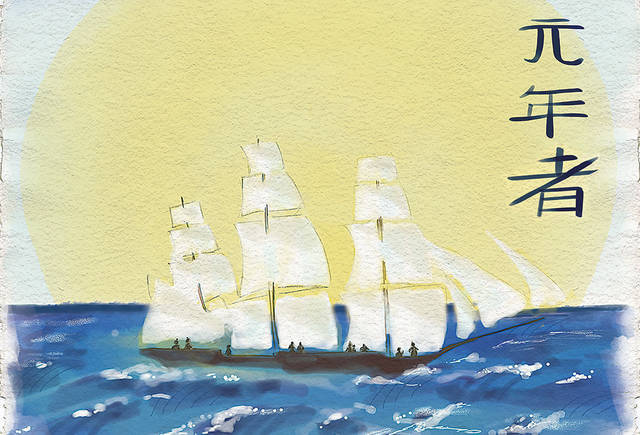Where the story of the Japanese in Hawaii begins

ILLUSTRATION BY MARTHA HERNANDEZ / MHERNANDEZ@STARADVERTISER.COM
Now, on the 150th anniversary of their arrival, the Gannenmono are getting their full due.
The story of modern Hawaii is also the story of the waves of Asian and European immigrants who came to the islands in the mid to late 19th century and early 20th century to toil in sugar and pineapple fields and on sprawling cattle ranges.
None have been as celebrated as the Issei, the 180,000 Japanese contract laborers who arrived from 1885 to 1924, and their descendants, the Nisei, or second-generation, U.S.-born Japanese who continue to play vital roles in Hawaii commerce, politics and community life.
But the Gannenmono were first.
On June 19, 1868 — 17 years before what is considered the first mass immigration of Issei to Hawaii — a diverse group of 149 men, women and children arrived in Honolulu Harbor after setting out from Yokohama 33 days earlier.
A motley group comprised the vanguard for future waves.
>> The early plantation workers began a journey in 1868 that changed the islands forever
Don't miss out on what's happening!
Stay in touch with breaking news, as it happens, conveniently in your email inbox. It's FREE!
THE DESCENDANTS
Local families connect with their Japanese roots.
>> Hawaii families discover connections to ancestors who toiled on plantations long ago
THE JOURNEY
A colorful account of strife on sea and land.
>> Dream of a ‘heavenly place’ turns to a nightmare of labor and abuse
They were called Gannenmono, or “first year people,” because they left their homeland in the first year of the Meiji Era in Japan.
Only about 50 of these pioneers would remain in Hawaii, dispersed across the island chain. Very few photos and artifacts of their often-harsh existence survive today, and the story of the Gannenmono was relegated to little more than a historical footnote.
The Gannenmono received token recognition in 1927 when the Japanese Friends of Hawaii built a memorial at Makiki Cemetery to honor their “pioneering spirit.” Two of the original arrivals, Sentaro Ishii of Maui, then 94, and Hanzo Tanagawa, 89, participated in the unveiling ceremony.
Bishop Museum historian DeSoto Brown notes that because the later-arriving Issei “are the ones who really established elements of Japanese culture here, … the Japanese who arrived in 1868 got little attention at the times of the 50th and 75th anniversaries of the 1885 immigrants, in 1935 and 1960.
“It wasn’t until the Gannenmono centennial in 1968 that more commemoration finally happened.”
The 100th anniversary celebration included a visit by Prince Hitachi and Princess Hanako of Japan’s imperial family, port calls by Japanese training ships and installation of memorial plaques at Honolulu International Airport. Various Japan prefectures installed Buddha statues, stone lanterns and a stone pagoda in Honolulu, Lahaina and Hilo.
Byodo-In Temple at Valley of the Temples in Kaneohe, a popular tourist attraction established in June 1968, is another monument to the very first Japanese immigrants to Hawaii.
Now, on the 150th anniversary of their arrival, the Gannenmono are getting their full due.
This year’s commemoration events, organized by Kizuna Hawai‘i, a consortium of 20 groups, and the Association of Nikkei & Japanese Abroad, include a convention and symposium, June 6 and 7 in Waikiki, exhibits at Bishop Museum and the Japanese Cultural Center of Hawai‘i, and appearances by Prince Fumihito and Princess Kiko, who will visit Hawaii for the first time, June 4 to 8, to attend some of the festivities.
Gannenmono Journey: Key Dates by Honolulu Star-Advertiser on Scribd





